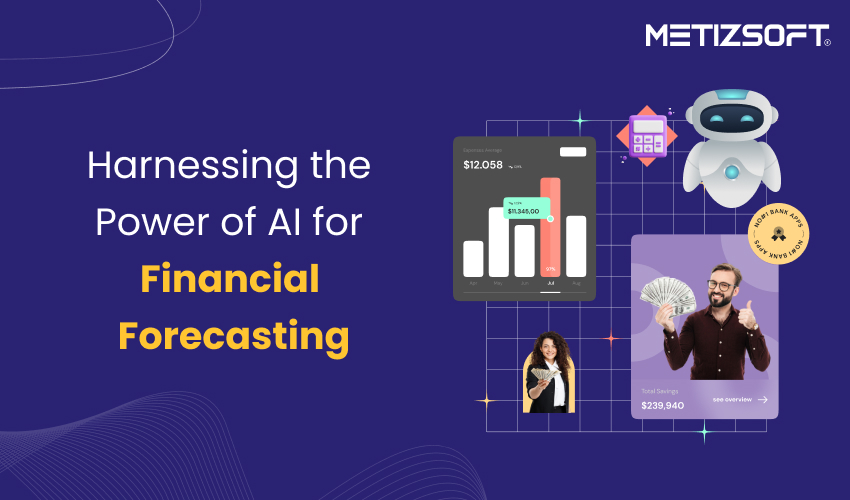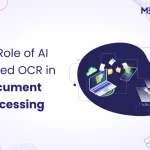
Table of Contents
Introduction
In the fast-paced and dynamic world of finance, the ability to predict forthcoming financial outcomes is essential for businesses. Accurate financial forecasting empowers organizations to make well-informed decisions, optimize resource allocation, and stay ahead of the competition.
By utilizing financial forecasting, businesses can anticipate upcoming revenues, expenses, and market trends. Ultimately, this allows them to proactively strategize and avoid potential challenges.
Artificial Intelligence (AI) revolutionizes financial forecasting by mitigating data complexities and helping tackle financial regulations. In 2023, the financial industry invested around 35 billion U.S. dollars in AI. The banking sector took the lead, contributing about 21 billion U.S. dollars.
This blog will explore the significance of financial forecasting. Here, we have compared traditional methods with AI-driven approaches and delved into the role of AI in integrating and analyzing data.
We will also discuss how AI helps manage data complexities and address financial regulations, offering key considerations for implementing AI in financial forecasting. Finally, we’ll look at real-world examples to highlight successful AI implementations.
Understanding Financial Forecasting
Financial forecasting is a critical process that involves utilizing historical data, evaluating market trends, and assessing economic conditions to predict a company’s future financial performance.
Ultimately, this forecasting is fundamental for budgeting, strategic planning, and maintaining positive investor relations. Accurate forecasts are invaluable as they empower businesses to allocate resources efficiently, anticipate shifts in the market, and uphold financial stability.
Traditional Methods VS. AI
Traditional financial forecasting methods rely on statistical models and manual data analysis. While these methods have been effective, they often struggle with large data sets and complex variables.
In contrast, AI-driven approaches leverage machine learning, neural networks, and predictive analytics to process vast amounts of data quickly and accurately, ensuring more reliable forecasts.
The Role of AI in Financial Forecasting
AI Technologies Used
Key AI technologies in financial forecasting include:
- Machine Learning (ML): ML algorithms analyze historical data to identify patterns and make predictions.
- Neural Networks: These models simulate the human brain’s processing to recognize complex patterns and relationships in data.
- Predictive Analytics: This technique uses statistical algorithms and ML to forecast future outcomes based on historical data.
Data Integration and Analysis
AI excels at integrating and analyzing large datasets from various sources. By processing and correlating data in real-time, AI provides accurate and timely financial forecasts, enabling businesses to make informed decisions quickly.
Real-Time Forecasting
AI enables real-time financial forecasting, updating predictions as new data becomes available. Mitigating Data Complexities with AI
Handling Big Data
AI’s advanced algorithms can handle and process vast amounts of financial data, overcoming the limitations of traditional methods. This capability ensures businesses can utilize all available data to make precise forecasts.
Data Quality and Accuracy
Ensuring data quality is paramount for accurate forecasting. AI systems can clean, validate, and standardize data, reducing errors and improving the reliability of forecasts.
AI-Driven Insights
AI can extract valuable insights from intricate datasets, revealing hidden patterns and correlations that traditional methods might overlook. These core insights are crucial in improving financial forecast accuracy and facilitating more informed decision-making.
Tackling Financial Regulations with AI
Regulatory Challenges
Financial regulations constantly evolve, and compliance is a significant challenge for businesses. Companies must adhere to stringent reporting standards and ensure transparency in their financial practices.
AI for Compliance
AI helps organizations comply with financial regulations by automating compliance processes, monitoring transactions, and identifying anomalies that may indicate non-compliance.
Automated Reporting
AI automates regulatory reporting, reducing the time and effort required to prepare reports. This automation ensures that reports are accurate, timely, and compliant with regulatory requirements.
Risk Management
AI identifies and mitigates financial risks by analyzing historical data and detecting patterns that indicate potential threats. This proactive approach enables businesses to address risks before they escalate.
Audit and Monitoring
AI improves audit processes by continuously monitoring financial transactions and flagging irregularities. This ongoing monitoring enhances the accuracy and efficiency of audits, ensuring that businesses remain compliant.
Key Considerations for Implementing AI in Financial Forecasting
Data Security and Privacy
When integrating AI into your current system, you must ensure high-level data security and privacy. Business owners should prioritize robust security measures to safeguard sensitive financial data from breaches and unauthorized access.
Choosing the Right AI Tools
Selecting the appropriate AI tools for financial forecasting is essential. Businesses should evaluate different AI solutions based on their needs, data types, and integration capabilities.
Training and Expertise
Implementing AI systems requires skilled personnel who understand both finance and AI technologies. Investing in training and hiring experts ensures that the AI systems are managed and operated effectively.
Integration with Existing Systems
AI must integrate seamlessly with existing financial systems to maximize its benefits. Proper integration ensures that AI-driven insights complement and enhance current forecasting processes.
Will AI Replace Accountants?
It’s a genuine question with lots of predictable and prediction-driven answers. But the straightforward answer as of now is NO!
AI undoubtedly has brought significant changes in the financial domain, but it hasn’t reached the point of human extinction.
Here’s why:
- Accounting involves understanding complicated business deals, rules, and industry details. Even though AI is advanced, it can’t use human judgment, ethics, and creativity, which are always necessary qualities.
- Building trust and maintaining client relationships are crucial in the accounting profession. Accountants often serve as clients’ trusted advisors. Indeed, AI cannot replicate interpersonal skills, communication, and the ability to understand specific financial goals and challenges.
- Human accountants are crucial in guiding businesses through financial complexities. While AI can handle data entry and analysis, it cannot consistently interpret results, provide context, or offer advice on strategic financial decisions.
Future of AI in Financial Forecasting
AI transforms financial forecasting by integrating and analyzing large datasets. It also provides real-time insights and ensures compliance with financial regulations. Consequently, businesses that leverage AI can enhance forecasting accuracy, improve decision-making, and manage risks more effectively.
The future of integrating AI in financial forecasting appears promising, driven by progress in machine learning, predictive analytics, and data processing. As AI technologies continue to advance, businesses stand to gain from deploying increasingly precise and efficient forecasting tools.
Discover state-of-the-art AI solutions tailored to address your financial forecasting requirements with Metizsoft, a highly regarded AI development service provider. Keep abreast of AI developments to uphold a competitive advantage within the dynamic financial landscape.
AboutManthan Bhavsar
Related Posts
ChatGPT vs Microsoft Copilot: Which AI Assistant is Better?
Picking the best AI assistant between Microsoft Copilot and ChatGPT largely depends on what you need and your work ethic....
How to Build an AI-Powered Laravel App With Claude Code and MCP Servers
Table of Contents SummaryIntroductionWhat Does AI Integration Look Like in Laravel?Getting Started: One-Command AI...

